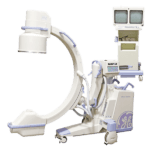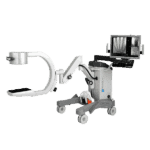The fluoroscopic c-arm process may be a bit scary for patients, but there are ways to lower the risk of both patient and staff
When a patient arrives to have imaging done at your facility, they almost always have concerns about radiation – does this sound about right?
Especially if they’re having interventional work done with a c-arm, patients will need reassurance from you and your staff. The fluoroscopic c-arm process may be a bit scary for patients, but there are ways to lower the risk of both patient and staff when it comes to these types of radiation exposing procedures. Federal regulations also state c-arm maximum output must have a limit.
So, what can you do to help keep fluoroscopic c-arm procedures safe for all involved?
- Keep strict rules regarding the persons allowed in the fluoroscopy room: No one should be present except trained staff and patient.
- Make sure patients are at least 12-15 inches away from the x-ray tube – the closer they are to the tube, the higher the radiation dose will be. However, your patient should be as close as possible to the image intensifier.
- Be honest and up front with your patients about the risks of radiation, but make it easy to digest by using simple language. Remember that your patients most likely won’t understand the terminology commonly used in the medical field.
- Ways to shorten fluoro times include: pulsed fluoro, manual mode, single pulse, timer warning, and image hold settings. You are also able to reduce radiation by using intermittent fluoroscopy and the image hold capacity simultaneously.
- You and your staff should keep at least one foot (or more) away from the patient during the procedure to lower radiation exposure.
Get Started
Request Pricing Today!
We’re here to help! Simply fill out the form to tell us a bit about your project. We’ll contact you to set up a conversation so we can discuss how we can best meet your needs. Thank you for considering us!
Great support & services
Save time and energy
Peace of mind
Risk reduction
- Stay mindful of radiation influx, and limit/adjust exposure time as needed.
- Make sure to thoroughly scan and go over the patients original radiographs before the fluoroscopic procedure begins, as this can greatly reduce the repeat rate for the procedure time.
- Avoid radiation leakage by having personnel stand on the image intensifier side of the c-arm while in use.
- Staff shielding! This should be a priority. Wear leaded eyewear with side shields, leaded gloves, and a wrap-around apron. The side shields on your eyewear are especially important, because without them you could accidentally glance sideways from the c-arm x-ray tube to look at the monitor image and be exposed to radiation. You don’t want that!
- Lead lining is also crucial in order to reduce radiation risk. However, lead requirements vary state to state, & you should find out your specific area’s rules and regulations before moving forward with any lead shielding.
———
Hopefully this post was a useful one! In addition to the above points, it’s important to inspect your c-arm and other medical equipment regularly to avoid any alignment issues or technical mishaps. With proper care, maintenance, and radiation safety taken into account, your c-arm will be an invaluable weapon in your imaging facility’s arsenal.
If you have any other questions concerning c-arms, radiation, or are on the market to buy or sell used/refurbished imaging equipment, feel free to reach out! Amber Diagnostics has a dedicated team of imaging professionals happy to serve. Contact us today!



